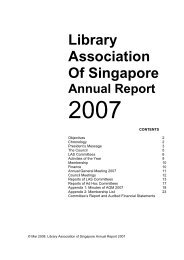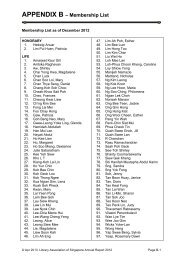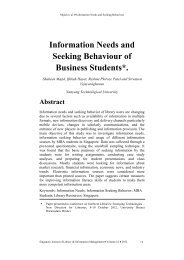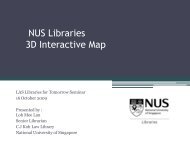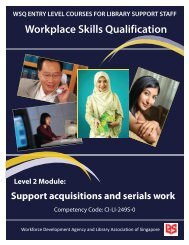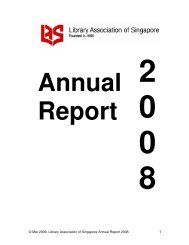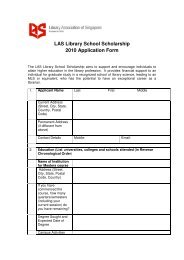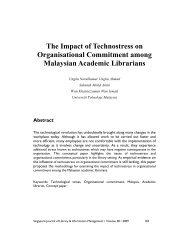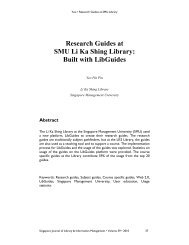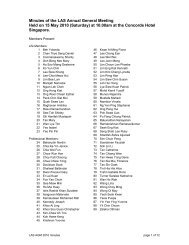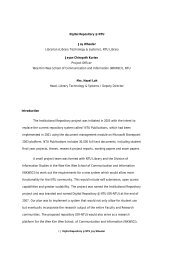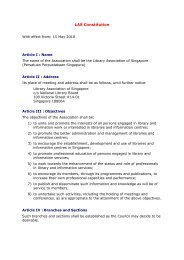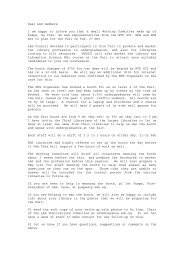Social Learning Spaces in the Li Ka Shing Library
Social Learning Spaces in the Li Ka Shing Library
Social Learning Spaces in the Li Ka Shing Library
You also want an ePaper? Increase the reach of your titles
YUMPU automatically turns print PDFs into web optimized ePapers that Google loves.
Yeo & R<strong>in</strong>dra • <strong>Social</strong> <strong>Learn<strong>in</strong>g</strong> <strong>Spaces</strong> <strong>in</strong> <strong>Li</strong> <strong>Ka</strong> Sh<strong>in</strong>g <strong>Li</strong>braryTable 1: Seat<strong>in</strong>g and Activities <strong>in</strong> Asia Pacific <strong>Li</strong>brariesSeat<strong>in</strong>g Available <strong>in</strong> Asia-Pacific<strong>Li</strong>brariesHow <strong>Li</strong>brarians Perceive <strong>the</strong>ir <strong>Li</strong>braries are be<strong>in</strong>g UsedType of Seat<strong>in</strong>gAsia-Pacific(n=71)ActivitiesGroup Tables87%Study81%Individual Carrels83%Top: UsuallyUse library computers80%Soft Seat<strong>in</strong>g79%Borrow a book55%OpenAreaCollaborative73%Ask questions or consultwith librarian75%Read<strong>in</strong>g Room<strong>Li</strong>brary Classroom68%Use own computersSometimes68%Attend tra<strong>in</strong><strong>in</strong>g ororientation66%64%CourseAreaReserve66%Meet withstudy group60%InformationCommonsProject Rooms56%Bottom:Visit <strong>the</strong> Café55%Not often/Never/NA Attend a function orexhibition39 %34%<strong>Li</strong>braries <strong>in</strong> <strong>the</strong> Asia Pacific are at <strong>the</strong>stage where <strong>the</strong>y provide soft seat<strong>in</strong>g, opencollaborative areas, <strong>in</strong>formation commons,classrooms and project rooms, beyond justgroup tables, <strong>in</strong>dividual carrels and coursereserve areas. The librarians also recognizethat <strong>the</strong>ir users come to do a varietyof activities. Perhaps more research couldbe done to confirm what our users areactually do<strong>in</strong>g <strong>in</strong> <strong>the</strong> library.Space Design for CollaborativeStudy AreaThe <strong>Li</strong>brary staff moved <strong>in</strong>to our newbuild<strong>in</strong>g <strong>in</strong> 2005. We took time to settle<strong>in</strong>to <strong>the</strong> build<strong>in</strong>g and made changes to <strong>the</strong>orig<strong>in</strong>al layout as we observed how ourstudents were us<strong>in</strong>g <strong>the</strong> spaces.S<strong>in</strong>gapore Journal of <strong>Li</strong>brary & Information Management • Volume 37 • 2008 51
Yeo & R<strong>in</strong>dra • <strong>Social</strong> <strong>Learn<strong>in</strong>g</strong> <strong>Spaces</strong> <strong>in</strong> <strong>Li</strong> <strong>Ka</strong> Sh<strong>in</strong>g <strong>Li</strong>braryBennett asked <strong>the</strong> question “How mightthis space be designed to encourage studentsto spend more time study<strong>in</strong>g?” butfor SMU which had already identified itslearn<strong>in</strong>g pedagogy, we asked a differentquestion. We asked <strong>in</strong>stead, “How couldwe design a study area for students thatreflected <strong>the</strong> way <strong>the</strong>y learned <strong>in</strong> <strong>the</strong> classroom?”The area on Level 2 orig<strong>in</strong>ally hadshelv<strong>in</strong>g for current journals with <strong>the</strong> usualtables and chairs. The area was clearedto host <strong>the</strong> open<strong>in</strong>g ceremonies for <strong>the</strong>campus. It was an opportunity to reconfigure<strong>the</strong> space to align it with studentlearn<strong>in</strong>g outside <strong>the</strong> classroom. The <strong>Li</strong>braryasked for and was successful <strong>in</strong> gett<strong>in</strong>gextra fund<strong>in</strong>g to convert <strong>the</strong> area <strong>in</strong>to acollaborative space. We came up with <strong>the</strong>follow<strong>in</strong>g design pr<strong>in</strong>ciples and mapped<strong>the</strong>m to <strong>the</strong> qualities of good library spaceas identified by McDonald (2006).A professional design firm, Philips Design,was used. We worked with Philips Designto come up with some prototypesbased on our design pr<strong>in</strong>ciples. For consistencywith o<strong>the</strong>r areas <strong>in</strong> <strong>the</strong> <strong>Li</strong>brary,<strong>the</strong> SMU corporate colour scheme wasused.The next question Bennett asked was:“What position on <strong>the</strong> spectrum from isolatedstudy to collaborative study shouldthis space be designed?” However <strong>in</strong> ourcontext, <strong>the</strong> <strong>Li</strong>brary already had 33 enclosedproject rooms which can be bookedby students, open tables, carrel seat<strong>in</strong>g forprivate study and casual seat<strong>in</strong>g (See Table2).We wanted this space to be for collaborativestudy and to be a lively discussionarea as envisioned by Freeman.Table 2: Design Pr<strong>in</strong>ciples & Qualities of <strong>Li</strong>brary SpaceDesignPr<strong>in</strong>ciplesQualitie sThe space encourages <strong>in</strong>teraction and participation.The space should be people-oriented. The studentsshould be able to configure <strong>the</strong> project spaces to<strong>the</strong>ir needs. Hence <strong>the</strong> furniture would need to beflexible and movable.The space should be accessible and must be easyto monitor when <strong>the</strong> library was open extendedhours. Hence <strong>the</strong> area would need to be open andyet give a sense of <strong>in</strong>timacy for <strong>the</strong> group us<strong>in</strong>geach pod.The space should be technology-enabled. Hencepower and network connections should be available.FunctionalAdaptableInteractiveConduciveVariedAcessibleSafe and secureEfficientEnvironmental suitableSuitable for <strong>in</strong>formation technology5 2 S<strong>in</strong>gapore Journal of <strong>Li</strong>brary & Information Management • Volume 37 • 2008
Yeo & R<strong>in</strong>dra • <strong>Social</strong> <strong>Learn<strong>in</strong>g</strong> <strong>Spaces</strong> <strong>in</strong> <strong>Li</strong> <strong>Ka</strong> Sh<strong>in</strong>g <strong>Li</strong>brary“<strong>Li</strong>braries must provide numerous technology-<strong>in</strong>fusedgroup study rooms andproject-development spaces. As “laboratoriesthat learn”, <strong>the</strong>se spaces aredesigned to be easily reconfigured <strong>in</strong>response to new technologies andpedagogies. In this <strong>in</strong>teractive learn<strong>in</strong>genvironment, it is important to accommodate<strong>the</strong> sound of learn<strong>in</strong>g – livelygroup discussions or <strong>in</strong>tense conversationsover coffee.”(Freeman, 2005, p. 5)We asked <strong>in</strong>stead “How can we use furnitureto create <strong>the</strong> feel of a collaborativeproject area <strong>in</strong> this open space?” Weplanned to develop a people-oriented andcontemporary layout that would appeal tostudents and meet <strong>the</strong>ir needs. We <strong>in</strong>volved<strong>the</strong> Dean of Students and <strong>the</strong> students atSMU <strong>in</strong> <strong>the</strong> design of <strong>the</strong> CSA. We hadstudents of all sizes and nationalities tryout different furniture configurations proposedby Philips Design. We <strong>in</strong>volved ourhandicapped students as well. In try<strong>in</strong>g todecide between two chair models, <strong>the</strong> studentsasked for and got both. The raised“lazy susan” proposed for <strong>the</strong> centre of<strong>the</strong> table to swivel a laptop was changedto be flush with <strong>the</strong> rest of <strong>the</strong> table as <strong>the</strong>students felt it was not practical and that<strong>the</strong> laptop wir<strong>in</strong>g would just get entangled.We planned publicity for <strong>the</strong> CSA. We hademail blasts about <strong>the</strong> CSA and held agrand open<strong>in</strong>g by <strong>the</strong> SMU President, ProfHoward Hunter on 9 November 2006. Ouruniversity newsletter, SMU Hub, publishedan article on <strong>the</strong> CSA <strong>in</strong> January 2007.Table 3: Layout of LKS <strong>Li</strong>braryLevel 2Entrance & Exit of <strong>Li</strong>braryCollaborative Study Area> Project spaces> Tables & seatsCustomer Services CentreCafeCourse Reserves> Tables & seatshttp://library.smu.edu.sg/images/L2.gifLevel 3Information Services Centre<strong>Li</strong>brary Computers<strong>Li</strong>brary OfficeRead<strong>in</strong>g area> Tables & seats> SofasProject RoomsReference & Periodicals Collectionhttp://library.smu.edu.sg/images/L3.gifLevel 4<strong>Li</strong>brary ComputersRead<strong>in</strong>g areas> Tables & seats> CarrelsProject RoomsLend<strong>in</strong>g Collectionhttp://library.smu.edu.sg/images/L4.gifLevel 5Tra<strong>in</strong><strong>in</strong>g RoomRead<strong>in</strong>g Room> Tables & seatsProject Roomshttp://library.smu.edu.sg/images/L5.gifS<strong>in</strong>gapore Journal of <strong>Li</strong>brary & Information Management • Volume 37 • 2008 53
Yeo & R<strong>in</strong>dra • <strong>Social</strong> <strong>Learn<strong>in</strong>g</strong> <strong>Spaces</strong> <strong>in</strong> <strong>Li</strong> <strong>Ka</strong> Sh<strong>in</strong>g <strong>Li</strong>braryTable 4: Rat<strong>in</strong>g of <strong>Li</strong>brary Build<strong>in</strong>g as a Place for Study<strong>in</strong>g and ResearchPoorAverageGoodExcellentGood &ExcellentResponseTotal20072 .3%11.4%53.5%31.5%85.0%94520061 .5%12.2%47.9%37.5%85.4%706Evaluation of <strong>Li</strong>brary Space &Collaborative Study AreaBennett recommended ask<strong>in</strong>g this question“How might this space enrich educationalexperiences?” when design<strong>in</strong>g alearn<strong>in</strong>g space. He proposed that by “provid<strong>in</strong>gcongenial, productive, and meritconferr<strong>in</strong>glearn<strong>in</strong>g spaces” to accommodate<strong>in</strong>dependent study, capstone experiences,and learn<strong>in</strong>g communities”, and notforgett<strong>in</strong>g hav<strong>in</strong>g serious conversationswith o<strong>the</strong>r students, it would make <strong>the</strong>sebehaviors more attractive to students toengage <strong>in</strong> (Bennett, 2007b, p. 22).We wanted to evaluate how successful <strong>the</strong><strong>Li</strong> <strong>Ka</strong> Sh<strong>in</strong>g <strong>Li</strong>brary was <strong>in</strong> be<strong>in</strong>g a research,social and event space for <strong>the</strong>SMU.The <strong>Li</strong>brary had done annual surveys <strong>in</strong>2006 and 2007. One of <strong>the</strong> questions askedwas: Rate <strong>the</strong> library build<strong>in</strong>g as a placefor study<strong>in</strong>g and research. We have ma<strong>in</strong>ta<strong>in</strong>ed<strong>the</strong> good and excellent rat<strong>in</strong>g at85%. (See Table 4).However, <strong>the</strong>re were no specific questionsabout <strong>in</strong>dividual areas <strong>in</strong> <strong>the</strong> <strong>Li</strong>brary. Asmaller survey was conducted <strong>in</strong> Marchto April 2008 to evaluate <strong>the</strong> CSA specifically.The total number of respondents was289 with undergraduates mak<strong>in</strong>g up 94%of <strong>the</strong> respondents. (See Table 5).The user satisfaction with <strong>the</strong> ambience,furniture and layout of CSA averaged 75%.The satisfaction with <strong>the</strong> Smartboard andwhiteboards was lower as users were notsure how to use <strong>the</strong> Smartboard and usersalso wanted consumables like paper, markersand erasers to be provided.Table 5: Rat<strong>in</strong>g of Collaborative Study AreaPoorAverageGoodExcellentGood &ExcellentResponseTotalA mbience 11.1%15.6%58.8%14.5%73.4%289F urniture11.4%12.5%51.9%24.2%76.1%289L ayout7 .3%16.7%62.9%13.2%76.0%288S martboard 8 .3%35.1%40.9%15.6%56.6%288W hiteboards 6 .6%31.3%44.6%17.4%62.0%2875 4 S<strong>in</strong>gapore Journal of <strong>Li</strong>brary & Information Management • Volume 37 • 2008
Yeo & R<strong>in</strong>dra • <strong>Social</strong> <strong>Learn<strong>in</strong>g</strong> <strong>Spaces</strong> <strong>in</strong> <strong>Li</strong> <strong>Ka</strong> Sh<strong>in</strong>g <strong>Li</strong>braryWe asked our users how <strong>the</strong>y were us<strong>in</strong>g<strong>the</strong> CSA. From <strong>the</strong> responses <strong>in</strong> Table 6,we can see that <strong>the</strong> social <strong>in</strong>teraction aspectwas strong (52%) when we comb<strong>in</strong>egroup discussion, group study and socialise.The use of <strong>the</strong> CSA for self study was44% as reported by our users.Table 6: Collaborative Study Area UseA nswer OptionsResponse %GroupDiscussion24. 3GroupStudy23. 0SelfStudy43. 9<strong>Social</strong>ise4. 8O<strong>the</strong>rs3. 9Totalrespondents285We also asked <strong>the</strong> students what improvements<strong>the</strong>y would like to see at CSA. Therewere 180 comments, of which 51% wason furniture, 16% noise levels, 13% overcrowd<strong>in</strong>g,11% usage of <strong>the</strong> space, 8%equipment and facilities.Out of <strong>the</strong> 92 comments on furniture, 74%were positive <strong>in</strong> ask<strong>in</strong>g for more of suchareas, more of such tables and seat<strong>in</strong>g.Some students suggested implement<strong>in</strong>gbook<strong>in</strong>g of <strong>the</strong> open project spaces, controlof usage, not allow<strong>in</strong>g reservation, andmany students reported difficulty <strong>in</strong> f<strong>in</strong>d<strong>in</strong>gan available space <strong>in</strong> CSA. These commentsthough negative from <strong>the</strong> userperspective, meant that <strong>the</strong> space washeavily utilized by our users.“Sweep<strong>in</strong>g” <strong>the</strong> <strong>Li</strong>braryAn <strong>in</strong>terest<strong>in</strong>g survey of two public libraries<strong>in</strong> Canada was done us<strong>in</strong>g a “seat<strong>in</strong>gsweeps method” where users were observedand data collected on <strong>the</strong> type ofuser, <strong>the</strong>ir activities and location where <strong>the</strong>activities were carried out. They used <strong>the</strong>“seat<strong>in</strong>g sweeps method” to verify userresponses <strong>in</strong> previous surveys. They foundthat <strong>the</strong>ir users were read<strong>in</strong>g (51%–64%),writ<strong>in</strong>g (18%–24%), talk<strong>in</strong>g (12%–20%),and us<strong>in</strong>g <strong>the</strong> computer (13%-15%).(Given & Leckie, 2003, p. 381)Table 7: Activities by Level <strong>in</strong> <strong>Li</strong> <strong>Ka</strong> Sh<strong>in</strong>g <strong>Li</strong>braryNumberLocationL2L3L4L5PercentTotal L2L3L4L5Tota lNoof users 232220522840833804728.8625.5035.2910.35Read<strong>in</strong>g1016567958326286743.7627.6333.7339.1435.63Writ<strong>in</strong>g339438704167164814.6021.3524.7920.0520.48Talk<strong>in</strong>g183179235476447.888.728.275.648.00Grpdiscussion 336455467220147814.4722.1716.4426.4118.37Usecomputer 41423852968124917.8311.6018.638.1615.52O<strong>the</strong>rs927656132373.963.701.971.562.95S<strong>in</strong>gapore Journal of <strong>Li</strong>brary & Information Management • Volume 37 • 2008 55
Yeo & R<strong>in</strong>dra • <strong>Social</strong> <strong>Learn<strong>in</strong>g</strong> <strong>Spaces</strong> <strong>in</strong> <strong>Li</strong> <strong>Ka</strong> Sh<strong>in</strong>g <strong>Li</strong>braryTable 8: Activities by Area <strong>in</strong> <strong>Li</strong> <strong>Ka</strong> Sh<strong>in</strong>g <strong>Li</strong>braryLocationCSAR OLC SA%ROL%RatioCSA/RO LNoof users4127635100100Read<strong>in</strong>g113275427.4336.070.76Writ<strong>in</strong>g3016187.2821.190.34Talk<strong>in</strong>g256196.078.110.75Groupdiscussion183129544.4216.962.62Uselaptop/ computer48134411.6517.600.66CSA = Collaborative Study Area project space & ROL = Rest of <strong>Li</strong>braryWe decided to use <strong>the</strong> method to see andverify <strong>the</strong> activities our users were engag<strong>in</strong>g<strong>in</strong> <strong>the</strong> library, with a special focus on<strong>the</strong> CSA. We conducted 2 “sweeps” a dayover 6 days <strong>in</strong> <strong>the</strong> first two weeks of April2008. Observations were staggered between11:30am to 7:00pm over <strong>the</strong> 6 days.We def<strong>in</strong>ed talk<strong>in</strong>g as a conversation betweentwo people and group discussion asa conversation between more than twopeople. Use of laptop and library computerwas counted when <strong>the</strong> user was observedto be us<strong>in</strong>g it.Look<strong>in</strong>g at <strong>the</strong> data for <strong>the</strong> whole <strong>Li</strong>braryfor each activity, we had similar resultswith Given & Leckie (2003). We foundthat our users were read<strong>in</strong>g (36%), writ<strong>in</strong>g(20%), group discussion (18%), talk<strong>in</strong>g(8%), us<strong>in</strong>g <strong>the</strong> computer (16%). Therewere some differences <strong>in</strong> <strong>the</strong> activitiespattern for <strong>the</strong> different levels. There wasless talk<strong>in</strong>g on Level 5 which is our quietestarea with more read<strong>in</strong>g on Level 2 <strong>in</strong>sideCourse Reserves, on Level 5 and onLevel 4 where we have carrels. There wasmore group discussion on Level 3, Level 4and Level 5 where we have project rooms.When we looked at <strong>the</strong> data for <strong>the</strong> CSAproject space and <strong>the</strong> data for <strong>the</strong> rest of<strong>the</strong> library (ROL), we got a different picture.The major activity at CSA was groupdiscussion (44%) which was 2.6 timesmore than <strong>the</strong> rest of <strong>the</strong> library as shown<strong>in</strong> Table 8.We compared <strong>the</strong> “sweep” results <strong>in</strong> <strong>the</strong>CSA with <strong>the</strong> responses <strong>in</strong> <strong>the</strong> survey.There was a good match for group discussionand o<strong>the</strong>rs, with over-report<strong>in</strong>g forself study and under-report<strong>in</strong>g by users forsocializ<strong>in</strong>g or talk<strong>in</strong>g as see <strong>in</strong> Table 9.Table 9: Use of CSA <strong>in</strong> Survey andSweepSurveyAnswerGroupdiscussion& GroupstudySelfstudyResponse%47.343.9SweepActivitiesGroupstudyRead<strong>in</strong>g& writ<strong>in</strong>gObserved%44.034.7<strong>Social</strong>ise4.8 Talk<strong>in</strong>g 6. 15 6 S<strong>in</strong>gapore Journal of <strong>Li</strong>brary & Information Management • Volume 37 • 2008
Yeo & R<strong>in</strong>dra • <strong>Social</strong> <strong>Learn<strong>in</strong>g</strong> <strong>Spaces</strong> <strong>in</strong> <strong>Li</strong> <strong>Ka</strong> Sh<strong>in</strong>g <strong>Li</strong>braryLKS <strong>Li</strong>brary as Event Space &Tra<strong>in</strong><strong>in</strong>g SpaceIn l<strong>in</strong>e with our strategic plan, <strong>the</strong> <strong>Li</strong>braryplaces an emphasis on hav<strong>in</strong>g events onits premises and conduct<strong>in</strong>g tra<strong>in</strong><strong>in</strong>gclasses. The number of events held and<strong>the</strong> number of tra<strong>in</strong><strong>in</strong>g classes are among<strong>the</strong> key performance <strong>in</strong>dicators of <strong>the</strong> <strong>Li</strong>brary.Over <strong>the</strong> period August 2005 to April 2008,91 events have been held at <strong>the</strong> <strong>Li</strong>brarywith an average of 30 events a year. Thetypes of events held were academic (40%),social (40%) and cultural (20%) <strong>in</strong> nature.Examples of each category were <strong>the</strong> InternationalResearch Conference andOpen Space Technology Class for academicevents, blood donation drive and studentclub annual d<strong>in</strong>ner for social events,and photograph exhibition and book fairfor cultural events.The <strong>Li</strong>brary started a series of cultural talks<strong>in</strong> February 2008 with <strong>the</strong> <strong>in</strong>augural talkby Ca<strong>the</strong>r<strong>in</strong>e <strong>Li</strong>m who spoke on “ThatDreaded F(reedom) Word” followed byT. Sasitharan who spoke on “Media Killed<strong>the</strong> Theatre Star” <strong>in</strong> March 2008.The <strong>Li</strong>brary has a purpose-built tra<strong>in</strong><strong>in</strong>groom that utilizes <strong>the</strong> SMU teach<strong>in</strong>g technologyof two project screens which canbe “frozen” <strong>in</strong>dependently. The room is <strong>in</strong>high demand as a tra<strong>in</strong><strong>in</strong>g space dur<strong>in</strong>gsemester by <strong>the</strong> <strong>Li</strong>brary, <strong>the</strong> Centre forTeach<strong>in</strong>g and <strong>Learn<strong>in</strong>g</strong>, <strong>the</strong> Centre of AcademicComput<strong>in</strong>g and <strong>the</strong> Centre for InformationTechnology. In 2006 and 2007,<strong>the</strong> Tra<strong>in</strong><strong>in</strong>g Room was booked by SMUstaff for 587 hours and 540 hours respectively.Table 10: Use of Read<strong>in</strong>g Room andTra<strong>in</strong><strong>in</strong>g RoomHours Booked for Events & Tra<strong>in</strong><strong>in</strong>gFacility20072006% changeRead<strong>in</strong>gArea 458.0 392.5 116. 7Tra<strong>in</strong><strong>in</strong>gRoom 540.5 587.5 92. 0998.5980.0 101. 9Areas for ImprovementBased on <strong>the</strong> comments from our surveyat <strong>Li</strong> <strong>Ka</strong> Sh<strong>in</strong>g <strong>Li</strong>brary, where 16% commentedon <strong>the</strong> noise levels, we realize thatwe need to better designate <strong>the</strong> noisyzones <strong>in</strong> <strong>the</strong> <strong>Li</strong>brary with <strong>the</strong> furnitureavailable and that we need to avoid hav<strong>in</strong>gquiet areas right next to <strong>the</strong> noisy areas.There is mix of <strong>in</strong>dividual seats andgroup seat<strong>in</strong>g <strong>in</strong> <strong>the</strong> CSA. This has lead todifferent expectations of noise levels by<strong>the</strong> users. The students at <strong>the</strong> <strong>in</strong>dividualtables want to do self study and were nothappy with <strong>the</strong> noise made by <strong>the</strong> studentshav<strong>in</strong>g discussions at <strong>the</strong> open projectspaces.There were comments on over-crowd<strong>in</strong>gand difficulty <strong>in</strong> f<strong>in</strong>d<strong>in</strong>g a space <strong>in</strong> CSA atpeak periods (13%). We <strong>in</strong>tend to rearrangeour exist<strong>in</strong>g furniture dur<strong>in</strong>g <strong>the</strong> vacation,to br<strong>in</strong>g <strong>the</strong> casual group seat<strong>in</strong>gdown to CSA and to move <strong>the</strong> <strong>in</strong>dividualseat<strong>in</strong>g to o<strong>the</strong>r levels. This would allowus to <strong>in</strong>crease <strong>the</strong> project spaces <strong>in</strong> <strong>the</strong>CSA and meet <strong>the</strong> demand for more opengroup spaces.With <strong>the</strong>se proposed changes, our userscould choose <strong>the</strong> area that best suits <strong>the</strong>irS<strong>in</strong>gapore Journal of <strong>Li</strong>brary & Information Management • Volume 37 • 2008 57
Yeo & R<strong>in</strong>dra • <strong>Social</strong> <strong>Learn<strong>in</strong>g</strong> <strong>Spaces</strong> <strong>in</strong> <strong>Li</strong> <strong>Ka</strong> Sh<strong>in</strong>g <strong>Li</strong>braryneeds, whe<strong>the</strong>r solitary or social. “Communalactivity <strong>in</strong> academic libraries is asolitary activity: it is studious, contemplative,and quiet. <strong>Social</strong> activity is a groupactivity: it is sometimes studious, not alwayscontemplative, and certa<strong>in</strong>ly notquiet” (Gayton, 2008, p. 60). Segregat<strong>in</strong>g<strong>the</strong> two types of spaces would allow bothtypes of activities to coexist <strong>in</strong> our <strong>Li</strong>braryand accommodate different user needs.ConclusionWe saw that our students are us<strong>in</strong>g <strong>the</strong><strong>Li</strong>brary for self study (56%) and groupdiscussion (18%). This is a positive signthat <strong>in</strong>dependent study, serious conversationswith o<strong>the</strong>r students, and participat<strong>in</strong>g<strong>in</strong> learn<strong>in</strong>g communities are <strong>the</strong> learn<strong>in</strong>gbehaviors that our students engage <strong>in</strong> atour <strong>Li</strong>brary. We saw that our students havemore group discussions and have moreface-to-face <strong>in</strong>teractions <strong>in</strong> <strong>the</strong> CollaborativeStudy Area.This <strong>in</strong>dicates that <strong>the</strong> furniture <strong>in</strong> <strong>the</strong> CSAis conducive to promot<strong>in</strong>g group work andhuman <strong>in</strong>teraction. We are meet<strong>in</strong>g <strong>the</strong>needs of our students as <strong>the</strong>ir course workrequires <strong>the</strong>m to <strong>in</strong>teract with one ano<strong>the</strong>rand to work collaboratively. We are provid<strong>in</strong>ga congenial, <strong>in</strong>vit<strong>in</strong>g space <strong>in</strong> <strong>the</strong><strong>Li</strong>brary that promotes social learn<strong>in</strong>g.We saw that our Read<strong>in</strong>g Room and Tra<strong>in</strong><strong>in</strong>gRoom were well-used for events andfor <strong>in</strong>struction. This <strong>in</strong>dicated that <strong>the</strong> <strong>Li</strong>brarybr<strong>in</strong>gs <strong>in</strong> both academic and nonacademicactivities <strong>in</strong>to our space and <strong>in</strong>tegratesus <strong>in</strong>to <strong>the</strong> SMU community.Salomon & Perk<strong>in</strong>s (1998) argued thatlearn<strong>in</strong>g not only takes place <strong>in</strong> <strong>in</strong>dividualm<strong>in</strong>ds but as part of social process todeepen <strong>in</strong>dividual learn<strong>in</strong>g and collectivelearn<strong>in</strong>g. The library can serve as a placewhere such learn<strong>in</strong>g can happen. “A studentcan go to this place called <strong>the</strong> “library”and see it as a logical extension of <strong>the</strong> classroom.It is a place to access and explorewith fellow students <strong>in</strong>formation <strong>in</strong> a varietyof formats, analyze <strong>the</strong> <strong>in</strong>formation <strong>in</strong>a group discussion, and produce a publicationor a presentation for <strong>the</strong> next day’ssem<strong>in</strong>ar” (Freeman, 2005, p. 4). In a conversationbetween <strong>the</strong> University <strong>Li</strong>brarianand <strong>the</strong> Dean of Students, AssociateProfessor Low Aik Meng <strong>in</strong> August 2007,he commented that “Knowledge is transferred<strong>in</strong> different ways and this needs tobe reflected <strong>in</strong> different spaces for <strong>the</strong> students.I f<strong>in</strong>d that <strong>the</strong> New <strong>Li</strong>brary (CSA)is a l<strong>in</strong>k between <strong>the</strong> classroom and <strong>the</strong>workplace.” The <strong>Li</strong> <strong>Ka</strong> Sh<strong>in</strong>g <strong>Li</strong>brary canserve as an extension of <strong>the</strong> classroom andalso a l<strong>in</strong>k to <strong>the</strong> workplace, where ourstudents would need to work <strong>in</strong>dependentlyand also <strong>in</strong> a team <strong>in</strong> open plan offices.We see that we are well on our way ofbe<strong>in</strong>g a “social” academic library “br<strong>in</strong>g<strong>in</strong>g<strong>in</strong> non-traditional functions like classrooms,event programm<strong>in</strong>g, and cafes <strong>in</strong>to<strong>the</strong> library” (Gayton, 2008, p. 62) and be<strong>in</strong>ga social learn<strong>in</strong>g space. As def<strong>in</strong>ed byWenger (1998), learn<strong>in</strong>g as experience,learn<strong>in</strong>g as do<strong>in</strong>g, learn<strong>in</strong>g as belong<strong>in</strong>g andlearn<strong>in</strong>g as becom<strong>in</strong>g can take place <strong>in</strong> ourlibrary.5 8 S<strong>in</strong>gapore Journal of <strong>Li</strong>brary & Information Management • Volume 37 • 2008
Yeo & R<strong>in</strong>dra • <strong>Social</strong> <strong>Learn<strong>in</strong>g</strong> <strong>Spaces</strong> <strong>in</strong> <strong>Li</strong> <strong>Ka</strong> Sh<strong>in</strong>g <strong>Li</strong>braryReferencesBennett, S. (2007a). Design<strong>in</strong>g for uncerta<strong>in</strong>ty:Three approaches. Journal ofAcademic <strong>Li</strong>brarianship, 33(2), 165-179.Bennett, S. (2007b). First questions fordesign<strong>in</strong>g higher education learn<strong>in</strong>gspaces. Journal of Academic <strong>Li</strong>brarianship,33(1), 14-26.Bruffee, K. (1981). Collaborative learn<strong>in</strong>g.College English, 43(7), 745-747.Cataldo, T. T., Freund, L., Ochoa, M. N.,& Salcedo, M. (2006). The <strong>in</strong>fo commonsconcept: Assess<strong>in</strong>g user needs.Public Services Quarterly, 2(4), 23-46.Freeman, G. T. (2005). The library asplace: Changes <strong>in</strong> learn<strong>in</strong>g patters, collections,technology, and use. In <strong>Li</strong>braryas place: Reth<strong>in</strong>k<strong>in</strong>g roles, reth<strong>in</strong>k<strong>in</strong>gspace (pp. 1-9). Wash<strong>in</strong>gton, DC:Council on <strong>Li</strong>brary and InformationResources.Gayton, J. T. (2008). Academic libraries:“<strong>Social</strong>” Or “Communal?” The natureand future of academic libraries. Journalof Academic <strong>Li</strong>brarianship, 34(1),60-66.Given, L. M., & Leckie, G. J. (2003).“Sweep<strong>in</strong>g” The library: Mapp<strong>in</strong>g <strong>the</strong>social activity space of <strong>the</strong> public library.<strong>Li</strong>brary & Information Science Research,25(4), 365.McDonald, A. (2006). The ten commandmentsrevisited: The qualities of goodlibrary space. <strong>Li</strong>ber Quarterly: TheJournal of European Research <strong>Li</strong>braries,16(1-4), 104-119.Pagell, R. A. (2007). Icons for <strong>the</strong>future: National and academic librariesfrom around <strong>the</strong> globe [ElectronicVersion]. Access. Retrieved April 23,2008 from http://www.aardvarknet.<strong>in</strong>fo/access/number63/monthnews.cfm?monthnews=05.Salomon, G., & Perk<strong>in</strong>s, D. N. (1998). Individualand social aspects of learn<strong>in</strong>g.Review of Research <strong>in</strong> Education, 23,1-24.S<strong>in</strong>gapore Management University.(2008). Vision and mission. RetrievedApril 23, 2008, from http://www.smu.edu.sg/about_smu/vision.aspS<strong>in</strong>gapore Management University. <strong>Li</strong> <strong>Ka</strong>Sh<strong>in</strong>g <strong>Li</strong>brary. (2008). Strategic plan.Retrieved April 23, 2008, from http://library.smu.edu.sg/aboutus/LKSLStratPlanShort62007_updfeb2008.pdfWenger, E. (1998). Communities of practice:<strong>Learn<strong>in</strong>g</strong>, mean<strong>in</strong>g, and identity.Cambridge: Cambridge UniversityPress.Yan, L., & Kember, D. (2004). Engagerand avoider behaviour <strong>in</strong> types of activitiesperformed by out-of-class learn<strong>in</strong>ggroups. Higher Education, 48(4),419-438.S<strong>in</strong>gapore Journal of <strong>Li</strong>brary & Information Management • Volume 37 • 2008 59
About <strong>the</strong> AuthorsYeo P<strong>in</strong> P<strong>in</strong>, Research <strong>Li</strong>brarian, support<strong>in</strong>g<strong>the</strong> School of Economics and <strong>the</strong>School of <strong>Social</strong> Sciences. She also manages<strong>the</strong> Information Services Centre <strong>in</strong><strong>the</strong> <strong>Li</strong>brary. She has an Honours degree<strong>in</strong> Economics from NUS and a post graduatedegree <strong>in</strong> Information Management and<strong>Li</strong>brarianship from UNSW.Email: ppyeo@smu.edu.sgR<strong>in</strong>dra Mokhtar b<strong>in</strong> Ramli, <strong>Li</strong>brarian with<strong>the</strong> Information Services Centre and also<strong>the</strong> <strong>Li</strong>brary webmaster. He also conductslibrary tra<strong>in</strong><strong>in</strong>g sessions for students andfaculty members. He has a Bachelor degree<strong>in</strong> Information Technology (InformationManagement) from QUT, Australiaand a Masters degree <strong>in</strong> Information Studiesfrom NTU. Email: r<strong>in</strong>dra@smu.edu.sg6 0 S<strong>in</strong>gapore Journal of <strong>Li</strong>brary & Information Management • Volume 37 • 2008




